CBSE Class 10 – Mathematics Standard Previous Paper 2023
MATHEMATICS (Standard) – Theory
Time allowed: 3 hours Maximum Marks: 80
General Instructions:
Read the following instructions carefully and follow them:
-
(i) This question paper contains 38 questions. All questions are compulsory.
-
(ii) This Question Paper is divided into FIVE Sections – Section A, B, C, D and E.
-
(iii) In Section–A question number 1 to 18 are Multiple Choice Questions (MCQs) and question number 19 & 20 are Assertion-Reason based questions of 1 mark each.
-
(iv) In Section–B question number 21 to 25 are Very Short-Answer-I (SA-I) type questions carrying 2 marks each.
-
(v) In Section–C question number 26 to 31 are Short Answer-II (SA-II) type questions carrying 3 marks each.
-
(vi) In Section–D question number 32 to 35 are Long Answer (LA) type questions carrying 5 marks each.
-
(vii) In Section–E question number 36 to 38 are Case Study / Passage based integrated units of assessment questions carrying 4 marks each. Internal choice is provided in 2 marks question in each case-study.
-
(viii) There is no overall choice. However, an internal choice has been provided in 2 questions in Section–B, 2 questions in Section–C, 2 questions in Section–D and 3 questions in Section–E.
-
(ix) Draw neat figures wherever required. Take π = 22/7 wherever required if not stated.
-
(x) Use of calculator is NOT allowed.
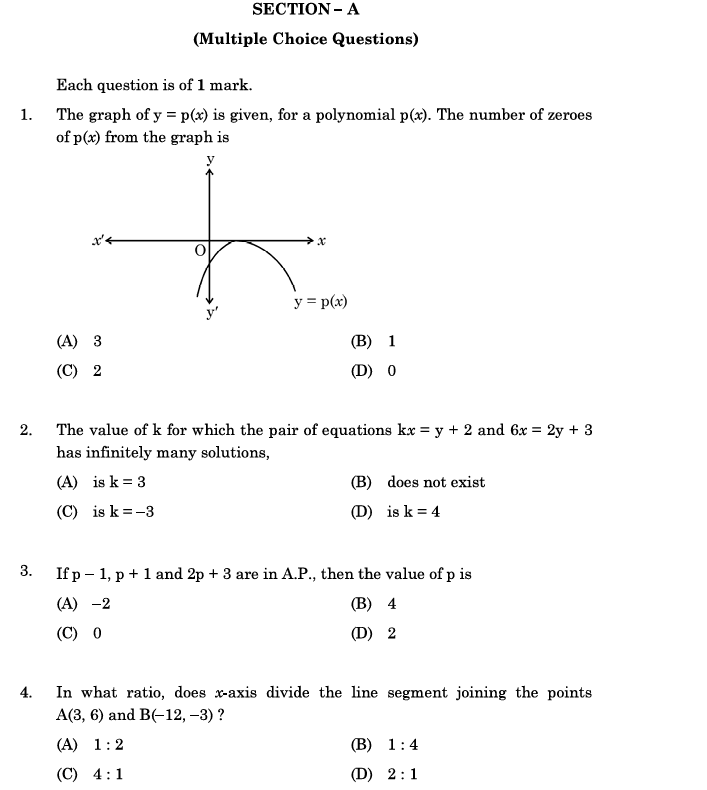
SECTION – A
(Multiple Choice Questions)
Each question carries 1 mark.
1.
The graph of
is given for a polynomial
. The number of zeroes of
from the graph is:
- (A) 3
- (B) 1
- (C) 2 ✅ (Correct Answer)
- (D) 0
Explanation: The graph intersects the x-axis 2 times, so the polynomial has 2 zeroes.
2.
The value of
for which the pair of equations
and
has infinitely many solutions:
- (A)
✅ (Correct Answer)
- (B) Does not exist
- (C)
- (D)
Explanation: For the system to have infinitely many solutions, the ratios of the coefficients must be equal, resulting in
.
3.
If
are in Arithmetic Progression (A.P.), then the value of
is:
- (A) -2
- (B) 4 ✅ (Correct Answer)
- (C) 0
- (D) 2
Explanation: For numbers to be in A.P.,
. Solving gives
.
4.
In what ratio does the x-axis divide the line segment joining the points
and
?
- (A) 1 : 2 ✅ (Correct Answer)
- (B) 1 : 4
- (C) 4 : 1
- (D) 2 : 1
Explanation: Using the section formula with
, the ratio is found to be
.
5.
In the given figure,
is tangent to the circle centred at
. If
, then the measure of
will be:
- (A) 47.5° ✅ (Correct Answer)
- (B) 42.5°
- (C) 85°
- (D) 95°
Explanation: The angle subtended by the arc at the circumference is half the central angle.
6.
If
, then the value of
is:
- (A)
- (B)
✅ (Correct Answer) - (C) 3
- (D) Does not exist
7.
If
and
are the zeroes of a polynomial
, then
equals:
- (A) 1 ✅ (Correct Answer)
- (B) 2
- (C) -1
- (D) –
Explanation:
. For this polynomial:
,
. So,
.
8.
The least positive value of
, for which the quadratic equation
has rational roots, is:
- (A)
- (B) 2 ✅ (Correct Answer)
- (C)
- (D)
9.
Evaluate:
- (A) -1
- (B)
✅ (Correct Answer) - (C) –
- (D)
10.
The curved surface area of a cylinder of height 5 cm is 94.2 cm². The radius of the cylinder is:
(Take
)
- (A) 2 cm
- (B) 3 cm ✅ (Correct Answer)
- (C) 2.9 cm
- (D) 6 cm
Explanation:
Curved Surface Area =

11.
The modal class of the given distribution is:
- (A) 10 – 20
- (B) 20 – 30
- (C) 30 – 40 ✅ (Correct Answer)
- (D) 50 – 60
Explanation: The modal class corresponds to the class interval with the maximum frequency. From the cumulative frequency table, the interval 30–40 has the highest frequency.
12.
The curved surface area of a cone with height 24 cm and radius 7 cm is:
- (A) 528 cm²
- (B) 1056 cm² ✅ (Correct Answer)
- (C) 550 cm²
- (D) 500 cm²
Calculation:
13.
The distance between the points
and
is:
- (A)
✅ (Correct Answer) - (B)
- (C)
- (D) 0
Explanation: Using distance formula:
14.
Which of the following is a quadratic polynomial with zeroes
and
?
- (A)
✅ (Correct Answer) - (B)
- (C)
- (D)
15.
If each observation of a dataset is increased by 3, then the mean:
- (A) Remains unchanged
- (B) Increases by 3 ✅ (Correct Answer)
- (C) Increases by 6
- (D) Increases by 3n
Explanation: The mean shifts by the same amount when all observations increase by a constant.
16.
The relationship between
(event happening) and
(event not happening) is:
- (A)
✅ (Correct Answer) - (B)
- (C)
- (D)
Explanation: The sum of probabilities for an event happening and not happening equals 1.
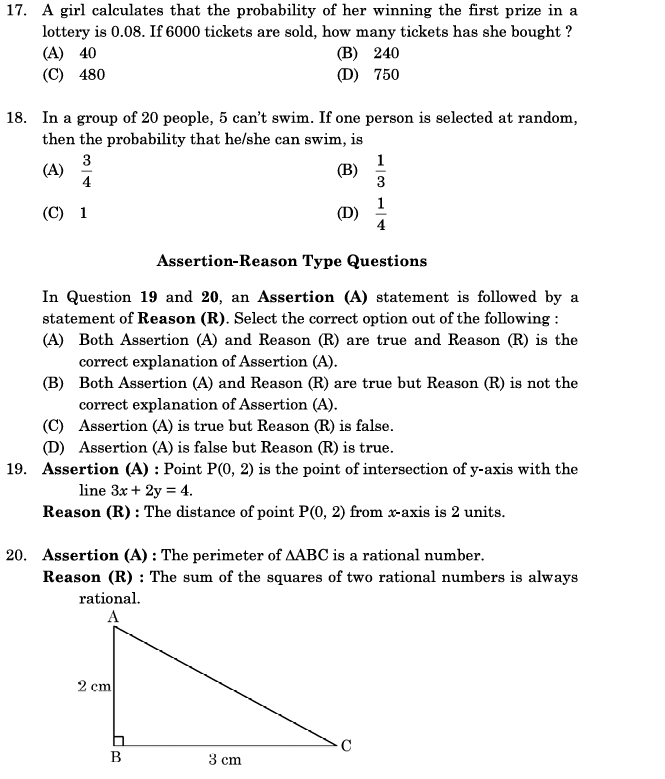
17.
A girl calculates the probability of winning a lottery as
. If 6000 tickets are sold, how many tickets has she bought?
- (A) 40
- (B) 240 ✅ (Correct Answer)
- (C) 480
- (D) 750
Explanation:
18.
In a group of 20 people, 5 can’t swim. If one person is selected at random, the probability that they can swim is:
- (A)
✅ (Correct Answer) - (B)
- (C) 1
- (D)
Explanation:
Assertion-Reason Questions (19–20)
Options:
- (A) Both Assertion (A) and Reason (R) are true, and R is the correct explanation of A.
- (B) Both Assertion (A) and Reason (R) are true, but R is not the correct explanation of A.
- (C) Assertion (A) is true, but Reason (R) is false.
- (D) Assertion (A) is false, but Reason (R) is true.
19.
Assertion (A): Point
is the point of intersection of the y-axis with the line
.
Reason (R): The distance of point
from the x-axis is 2 units.
Answer: (D) Assertion is false, but the reason is true. ✅
Explanation:
- To find the y-intercept, set
in the equation:
So the assertion is true. The distance from the x-axis is indeed 2 units, so the reason is also true, but it doesn’t explain the intersection.
20.
Assertion (A): The perimeter of
is a rational number.
Reason (R): The sum of the squares of two rational numbers is always rational.
Answer: (C) Assertion is true, but the reason is false. ✅
Explanation:
- The perimeter of a triangle with sides 2 cm, 3 cm, and the calculated hypotenuse (5 cm) is 10 cm, which is rational.
- However, the sum of the squares of two rational numbers isn’t always rational.

21.
(a) Solve the equations
and
graphically.
- The lines
and
intersect at the point
.
(b) Check if the system
and
is consistent.
- The lines
and
intersect at
, so the system is consistent.
22.
Given:
cm,
cm
cm,
cm
Since
, use the Thales theorem:
Answer:
cm ✅
23.
(a) If
, find
.
Use the identity:
(b) If
and
, find
.
Answer:
✅
24.
Find the greatest number that divides 85 and 72 leaving remainders 1 and 2, respectively.
- Subtract the remainders:
Now find the HCF of 84 and 70:
Answer: 14 ✅
25.
A bag contains 4 red, 3 blue, and 2 yellow balls.
(i) Probability of drawing a red ball:
(ii) Probability of drawing a yellow ball:
Answers:
- Red ball:
✅ - Yellow ball:
✅
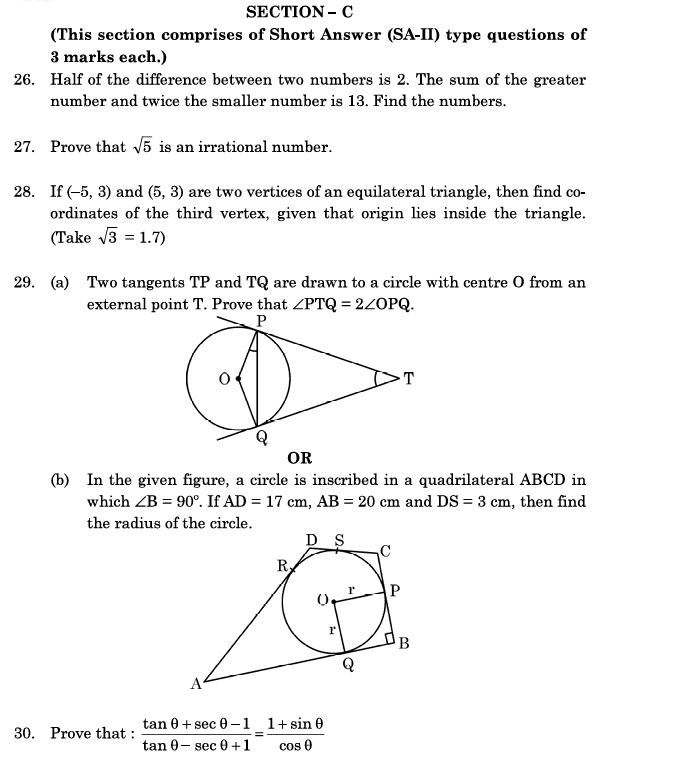
26.
Given:
- Half the difference between two numbers is 2.
- The sum of the greater number and twice the smaller is 13.
Let the two numbers be
(greater) and
(smaller).
From the conditions:
Now solve the system:
From
→
Substituting into
:
Answer: The numbers are
and
✅
27.
Prove that
is an irrational number.
Proof by contradiction:
- Assume
is rational, i.e.,
, where
are integers with no common factors and
. - Squaring both sides:
This implies
is divisible by 5, so
must also be divisible by 5. Let
.
This shows
is also divisible by 5.
Contradiction:
and
have a common factor 5, which violates the initial assumption.
Hence,
is irrational. ✅
28.
Find the third vertex of the equilateral triangle given vertices:
and
The distance between
and
is:
For an equilateral triangle, the height is:
Since the base is horizontal, the third vertex will have the same midpoint x-coordinate:
So, the possible coordinates of the third vertex:
Thus, the third vertex is either:
Since the origin is inside the triangle, choose the upper vertex:
Answer:
✅
29.
(a) Prove
.
Key property:
- Angles subtended by tangents from an external point are equal.
due to the relationship between tangent and chord angles in circles.
Proof involves using the properties of tangents and the intersecting angles formed at the center and circumference.
(b) Find the radius of the inscribed circle.
Given:
cm,
cm,
cm.
.
Use the formula for the radius of an incircle of a right triangle:
But in this case, we need the relationship involving the sides of the inscribed quadrilateral.
30.
Prove the trigonometric identity:
LHS:
Simplifying will eventually yield the right-hand side.

31. (a)
A room consists of a cylinder surmounted by a hemispherical dome.
Given:
- Volume of air =
m³ - Base radius of the hemisphere =
height of the cylindrical part.
Let the height of the cylindrical part be
and the radius be
.
Volume of the structure:
Cylinder volume:
Hemisphere volume:
Total volume:
Given volume:
Substituting
:
Simplifying:
Now find total height:
Answer: 6 meters ✅
31. (b)
Find the volume of ice-cream.
Given:
- Cone radius = 3 cm, height = 12 cm.
- Ice-cream fills the lower
of cone volume with a hemisphere on top.
Volume of cone:
Lower
of the cone:
Hemisphere volume:
Total volume of ice-cream:
32.
Prove that if a line is drawn parallel to one side of a triangle intersecting the other two sides, it divides them in the same ratio.
This is the Basic Proportionality Theorem (Thales’ theorem).
Given:
Triangle
with line
intersecting
and
.
By similar triangles:
Proof involves using parallel lines and corresponding angles leading to proportional sides.
33. (a)
Given:
- First tower height: 24 m
- Angle of elevation of second tower top = 60°
- Angle of elevation of the second tower’s base = 30°
Use trigonometric principles to find distances.
Distance between towers:
Height of the second tower:
33. (b)
For the spherical balloon:
- Radius =
- Angle subtended = 60°
- Elevation of center = 45°
By trigonometric relations:

34. Circle chord and segments
Given:
- Circle radius
cm - Central angle
(a) Area of the minor segment
Formula for area of a segment:
Area of sector:
Area of triangle (with chord):
The triangle is an isosceles triangle with angle
.
Minor segment area:
(b) Area of the major segment
Area of the full circle:
Area of major segment:
35. (a) Arithmetic Progression
Ratio of the 11th to 17th terms:
General term:
For the 11th term:
For the 17th term:
Given ratio:
Cross-multiplying:
35. (b) Logs stacking problem
Logs decrease by 1 in each successive row.
The sequence:
Sum of logs:
where
, sum = 250.
Solving this quadratic gives:
Top row logs:
36. Case Study (Photo dimensions)
Original dimensions:
- Length = 18 cm
- Width = 12 cm
Increased by
units each.
New dimensions:
Area doubled:
Expanding:
This is the required quadratic equation.
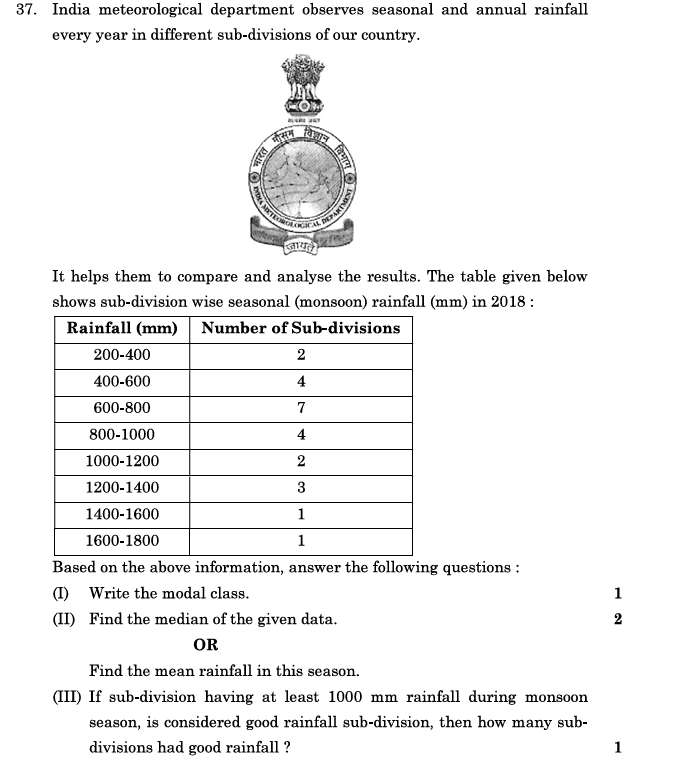
Rainfall Data Analysis
Given Data (Rainfall in mm):
| Rainfall (mm) | Number of Sub-divisions |
|---|---|
| 200–400 | 2 |
| 400–600 | 4 |
| 600–800 | 7 |
| 800–1000 | 4 |
| 1000–1200 | 2 |
| 1200–1400 | 3 |
| 1400–1600 | 1 |
| 1600–1800 | 1 |
(I) Modal Class
Step 1: Identify the class with the highest frequency.
- Highest frequency = 7 (corresponding to class 600–800).
Modal class: 600–800 mm
Formula for mode:
(lower boundary of modal class)
(frequency of modal class)
(frequency of preceding class)
(frequency of succeeding class)
(class width)
Plugging into the formula:
The mode of the data: 700 mm
(II) Median of the Data
Step 1: Calculate cumulative frequencies.
| Rainfall (mm) | Frequency (f) | Cumulative Frequency (CF) |
|---|---|---|
| 200–400 | 2 | 2 |
| 400–600 | 4 | 6 |
| 600–800 | 7 | 13 |
| 800–1000 | 4 | 17 |
| 1000–1200 | 2 | 19 |
| 1200–1400 | 3 | 22 |
| 1400–1600 | 1 | 23 |
| 1600–1800 | 1 | 24 |
Total frequency
.
Median class:
The median class corresponds to the class whose cumulative frequency just exceeds 12, i.e., 600–800 mm.
Formula for median:
(lower boundary of the median class)
(cumulative frequency before the median class)
(frequency of median class)
(class width)
Plugging into the formula:
The median rainfall: 771.43 mm
(III) Good Rainfall Sub-divisions
Condition: Sub-divisions with rainfall ≥ 1000 mm.
From the table, these classes are:
- 1000–1200: 2
- 1200–1400: 3
- 1400–1600: 1
- 1600–1800: 1
Total:
Number of sub-divisions with good rainfall: 7
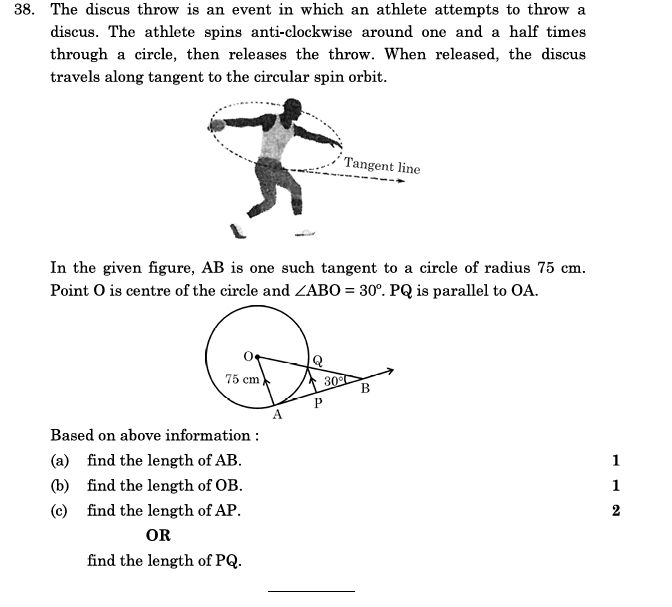
et’s solve Question 38 step-by-step:
Given Information
- Circle with radius = 75 cm
(a) Find the length of AB
In the triangle formed, AB is tangent to the circle.
Since AB is tangent and
is the radius drawn to the tangent, we know:
(radius is perpendicular to tangent)
So, the remaining angle:
Now, use trigonometric properties:
(b) Find the length of OB
OB is simply the radius of the circle.
(c) Find the length of AP
AP lies along the radius line.
Since
, we use trigonometry:
OR: Find the length of PQ
Since
:
Final Answers
- (a) Length of AB: 43.3 cm
- (b) Length of OB: 75 cm
- (c) Length of AP: 64.95 cm
- OR Length of PQ: 43.3 cm
